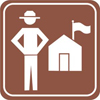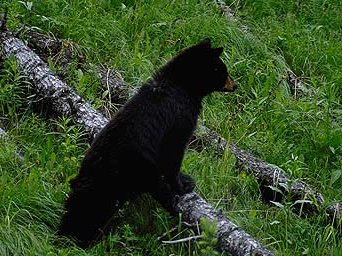 |
 |
 |
 |
 |
 |
 |
 |
|
Archived News
Care of Catch improves Meal Quality
Ponds filled with great blue herons, Canada geese, ducks, and other birds just became easier to view with the opening of the Lee Kay Ponds Auto Loop Road. Located on Division of Wildlife Resources' property south of the Salt Lake Valley Solid Waste Facility at 6030 W. California Ave., the Lee Kay Ponds provide people in the Salt Lake Valley a place to relax and enjoy nature and wildlife viewing. The auto loop road, which provides excellent viewing of the ponds, officially opened May 10. Bob Walters, Watchable Wildlife Program Coordinator for the Division of Wildlife Resources, reported, "This is a great wildlife viewing area that isn't far from the heart of the Salt Lake Valley. We're surrounded by urban sprawl in the valley and need open space. These ponds help provide that." The Lee Kay Ponds Auto Loop Road was built near the ponds by the Salt Lake Valley Solid Waste Facility. The road includes four wildlife viewing pullouts and a gazebo, complete with binocular viewers. "The facilities the solid waste facility has built are very, very nice and provide people a comfortable way to relax and watch the myriad of birds that use the area," Walters said. The auto loop road is open year-round, from 8 a.m. to 5 p.m. Mondays through Saturdays, excluding Thanksgiving, Christmas and New Year's Day. For more information, call Walters at (801) 538-4771 or the Salt Lake Valley Solid Waste Facility at (801) 974-6902.
New Book Shares First Aid Information By Brian Brinkerhoff Outdoors Correspondent First aid information awaits at your fingertips with the compact and easy to use wilderness and travel first aid manual, A Comprehensive Guide to Wilderness and Travel Medicine, written by Eric. A. Weiss, MD.. This lightweight companion, weighing only ounces and small enough to fit in your back pocket, can easily prove itself to be an important asset to you on the road or on the trail. While other guides get left behind because of their inconvenient size or weight, this guide can always stay in the vehicle's glovebox or inside your first aid kit, making it much more valuable to you in an emergency, rather than gathering dust on your bookshelf. Packed full of information, this guide provides checklists to help you decide if an illness or injury warrants immediate evacuation. It also provides over 50 "Weiss Advice Improvised Techniques", including facts such as that melted candle wax can make a great emergency replacement for lost fillings or that honey can make a good antibiotic ointment. With over 70 helpful illustrations and the expanded "Fast Index" on the back cover, information is easily available in emergency situations, when immediate action is required without impatient thumbing through the pages for the information required. Weiss currently serves as the Associate Director of Trauma and Assistant Professor of Emergency Medicine at Stanford University Medical Center as well as Medical Director and Founder of Adventure Medical Kits, currently used worldwide. A Comprehensive Guide to Wilderness and Travel Medicine is available at many stores or can be purchased directly form Adventure Medical Kits for under $7.00. For more information or to purchase a copy, contact Adventure Medical Kits at 1-800-324-3517.
Conservation Seedlings Available By Brian Brinkerhoff Outdoors Correspondent Orders are now being accepted for low-cost tree and shrub seedlings for use in windbreaks, wildlife habitat, and erosion control. The Utah Division of Forestry, Fire and State Lands, located at the Lone Peak Conservation Nursery, is currently offering seedlings for conservation purposes, costing approximately 65 cents each, with a minimum order of 100 seedlings.
These seedlings are not appropriate for landscape plantings, due to shape and size of the seedlings, according to Beagle. He explained, "The seedlings are conservation grade and not acceptable for landscape plantings." Beagle added, "Choice of native plants and seed source integrity are important to match the plant to different regions of the state. The state nursery produces unique plants meeting conservation needs for most areas of the state and we're proud to state that they are a homegrown 'Product of Utah.'" Although large companies and state agencies purchase many seedlings, Lone Peak State Nursery provides information for smaller landowners, new to conservation plantings. Former manager, John Justin, concluded, "We do want to emphasize that we are available for anyone in the state for conservation purposes." To help beginners, several free brochures are available at the nursery discussing wildlife planting, development of windbreaks, and proper planting of seedlings. To help select proper species, Trees for Conservation is a buyers guide, available for $5.00. Their video, available for $10.00, is produced for the layman to understand basic seedling planting techniques. Seedlings may be ordered by mail, or through any of the six area offices of Forestry, Fire, and State Lands. For more information, contact any state forestry office or the Lone Peak Conservation Nursery at 271 West Bitterbrush Lane, Draper, Utah 84020, (801)571-0900. Their website is located at www.nr.state.ut.us/slf/lonepeak/home2.htm.
Several Resources available for Wildlife Planning By Brian Brinkerhoff Outdoors Correspondent With spring weather just around the corner, landowners should now be planning their upcoming landscaping needs. As plans are developed, don't forget to include enhancements which attract wildlife, adding extra magic to the scenery. Whether you plant flowers to attract butterflies or trees to provide homes for songbirds, the enhancements will offer rewards for seasons to come. Landowners have several resources available when planning to enhance wildlife visitation on their property and increase the natural beauty of their land. The following references are particularly good sources of information and are highly recommended. Private landowners, interested in planting large numbers of conservation seedlings, should take a look at the Tree and Shrub Planting Handbook--A Guide for Conservation Plantings in Utah and Nevada. Prepared by the Utah and Nevada Division of Forestry, USDA Soil Conservation Service, and the USDA Forest Service, it specifically discusses conservation plantings in our arid state. Topics range from erosion control, snow management, and wildlife habitat to Christmas trees, fuel wood, and roadside plantings. This text helps landowners define their needs and determine how they can most effectively design their plantings to meet those needs. This resource is highly recommended when serious land management for conservation use is considered. It's detail examines design, planting, establishment, and maintenance of conservation plantings, with a large section dedicated to windbreak plantings, considering various soil types. Included with the Tree and Shrub Planting Handbook, is a booklet titled, Trees for Conservation--A Seedling Buyers Guide for Utah and Nevada, which discusses trees most appropriate for this climate. Information provided for each species includes life span, drought resistance, disease problems, and color photographs. Single copies of the combined handbooks are available for $40.00, including shipping and handling, while multiple copies are ordered for $35.00 each. To order these handbooks, contact David Schen or Molly Bishop at the Department of Sovereign Lands and Forestry, 3 Triad Center, Suite 425, 355 West North Temple, Salt Lake City, Utah 84180-1204 or call them at (801) 538-5555. Voyageur Press has published an effective guide for all wildlife enthusiasts, interested in viewing more wildlife in their backyards. Attracting Backyard Wildlife--A Guide for Nature Lovers provides many interesting ideas and plans for attracting butterflies, birds, and other animals to your backyard. Topics include backyard ponds, caring for injured animals, hummingbird feeders, and appropriate seed mixtures for wintering birds. Author, Bill Merilees provides construction diagrams and other practical tips to increase visitation and make wildlife viewing more enjoyable in your backyard. He discusses water for wildlife, brush piles, and wildlife gardening for apartment dwellers. If your interest includes building bird feeders and bird houses or designing a trap to reduce those pesky wasps, this book will be worth viewing. Cover price is $10.95 and Voyageur Press can be contacted by calling 1-800-888-9653. Creating Landscapes for Wildlife...A Guide for Back Yards in Utah, published by the Division of Wildlife Resources, is an inexpensive wealth of information designed for wildlife enthusiasts. This booklet emphasizes developing a landscape plan for wildlife and utilizing native flowers, trees, and shrubs, which attract and benefit wildlife. Butterflies, birds, and reptiles are listed with their favorite food sources and habitats. This text provides very specific information as it divides the state into various regions and lists appropriate plant species for each region. Creating Landscapes for Wildlife...A Guide for Back Yards in Utah is available at all Division of Wildlife Resources offices.
|
||||||||||||||||||||||||||||||
|
Backcountry Radio Network, 6700 South 3600 West, Benjamin, Utah 84660 |
||||||||||||||||||||||||||||||
|
To Advertise Phone:
801-360-3645 • Email: advertise@backcountrynetwork.com |










